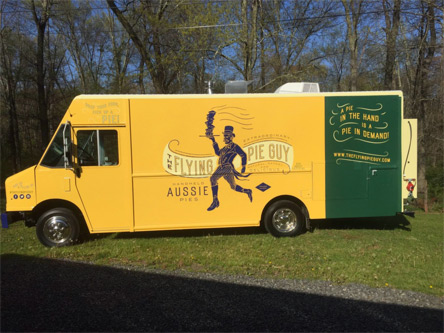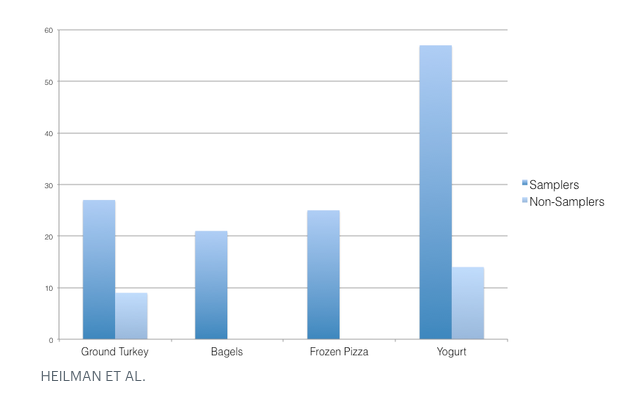Offering free samples is one of the oldest ways to market and generate interest in a new food product. You see this all the time when you visit the giant discount retailers like Costco. Part of the attraction for many Costco members is visiting the store is to see what type of snacks, entrees, drinks and deserts will be on display to try for free. Offering a free sample is an effective way to get potential customers to experience your product without risk. But does it make wise business sense to offer freebies from your food truck like bigger businesses?
It’s one thing for a behemoth like Costco that generated a reported $163 billion in sales in 2017 to offer free soda to guests. They’ve got the established business, membership revenue, and sales volume to support this marketing expense. But it’s entirely different situation for concession businesses like yours where the expense of every free sample comes directly out of your pocket book.

The Flying Pie Guy. Built by M&R Specialty Trailers and Trucks.
Does Offering Free Samples Really Work?
There are common fears associated with offering a free food sample. The first fear is that people will take advantage of free samples. Instead of taking just one sample, they might take four or five tastes. Then they might invite their wife, five kids, and buddies to sample your food with zero intent to purchase. This scenario is probably more rare than imagine, but it’s something you’ll probably experience if you offer free samples long term.
There’s also the fear that free samples won’t actually increase sales. People that try free samples are viewed as cheap and not the buyers. No doubt there is some level of truth to both of these examples. But does the business upside outweigh these risks?
Much has been written about the psychology of free samples. You can read more details on reasons why free samples work, but it mostly comes down to people’s natural inclination to reciprocate. To put it in plain English, if someone does something nice for you then you want to do something nice in return. It’s a built-in trait that most of us humans share.
A quote taken from “The Psychology Behind Costco’s Free Samples” published by TheAtlantic.com explains this cerebral occurrence well:
“Reciprocity is a very, very strong instinct,” says Dan Ariely, a behavioral economist at Duke University. “If somebody does something for you, you really feel a rather surprisingly strong obligation to do something back for them.”
In addition to the psychological supporting evidence on why free stuff works, there’s also supporting sales data provided in the same article below. The chart below shows how volume of sales increased for each of the following product items during an experiment conducted in a grocery store. As you can see, the total number of sales increased across all product categories after free samples where tried.
What Should You Offer as a Free Product?
Even though free samples will be an expense for your business, it’s worth having this option in your marketing quiver to drive more sales if needed at events. This tactic particularly valuable during slower periods to drive more sales during off-peak hours. When business picks up and your line is long, you can stop serving free samples and focus on serving the paying customers.
While free samples has proven to be an effective way to drive interest and sales, you’ll need to be smart about what you offer as a free sample. For example, higher-cost pieces of ribeye would be a freebie that would no doubt attract a crowd, but might also put you out of business due to the high cost. When looking for a free offer you want to offer a product that tastes great and reflects your menu, but is also low-cost to you. We’ve written in the past about some of the highest-margin concession foods, but some good places to identify free samples are below:
Bread Products: Bread products are cheap. You’ve no doubt been in a shopping mall where they hand out fresh baked pretzel samples or flat breads. These products are both tasty and low-cost to serve. The same process can be used for all kinds of starch-heavy products like donuts, bagels, pizza, and bread sticks.
Ice Cream / Frozen Yogurt: If you’ve ever been to an ice cream shop or frozen yogurt spot you know they’ll always offer a free sample. The reason? The process works and is an extremely affordable way to generate sales when it costs under 10 cents per sample. When an ice cream cone is sold as a direct result of a free sample, the profit-margin is often well over 50% meaning you’ve profited handsomely even if you only make one extra sale per 20 freebies given away.
Popcorn: Kettle corn vendors understand that because the cost of their product is so low, it can be given away profitably to generate additional sales.
Chips: Most sit down Mexican restaurants serve you free chips and salsa when you order a meal. In addition to this being an expectation at sit-down restaurants, it’s also an extremely low-cost offering. Chips cost almost nothing to serve.
Beverages: Things like teas, coffees, and other specialty drinks can be the ideal freebie. Especially if you’re serving at summertime event. You could get creative by serving a flavored peach tea. If you make peach tea in bulk it can be distributed for pennies to prospective buyers.
Estimating Your Return on Investment
As a business owner, it’s your duty to ensure the food truck is bringing in enough money to support all the expenses and provide a comfortable lifestyle for your family. As part of this fiscal duty, you’ll want to ensure all these giveaways are delivering a return on investment.
You can determine if the giveaway is producing results by figuring out your free sample conversion rate. Here’s the conversion rate formula for free samples:
Number of Free Samples Given / Number of Buyers that Purchased Product after Receiving Free Sample = Conversion Rate
Here is a real-life example on what this might look like:
100 free samples given away / 20 purchases made after a free sample tasting = 20% conversion rate.
This means that for every five samples you give away from a food truck, you get one new purchase on average as a result. Assuming you were giving away a freebie that was low-cost and low-effort to produce, this formula could end up being highly profitable for your business.
At the end of the day, you’ll need to test different free samples to understand the thing that works best for your business. If you are taking the time to understand how many free samples you give away to determine, the cost, and the conversion rate that people end up purchasing your product, you’ll be confident that your marketing efforts are driving profits and not taking away from your business.
Do you currently offer free samples on your food truck? If so, let us know what you offer and whether or not it works in the comment section below.

